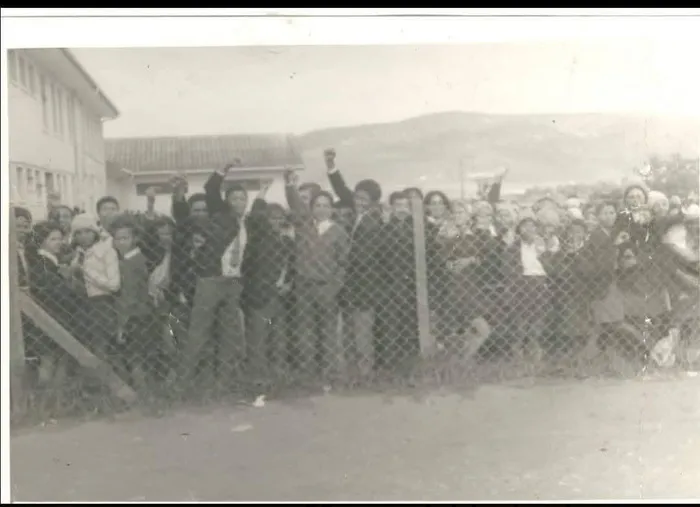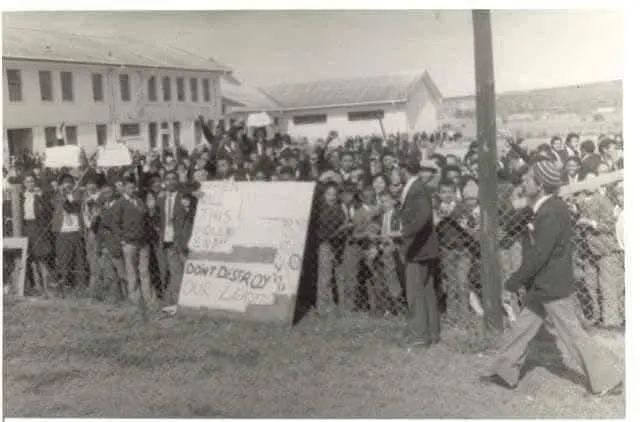Uitenhage High School contributed immensely to June 16 uprisings

About 40 Uitenhage High School students and adults were arrested and charged under the “Riotous Assembly Act”.
Image: Terry Hendrickse
Peter A C Hendrickse
On June 16, 1976, the long simmering frustration, discord and opposition to apartheid was smouldering in South Africa.
All it needed was a spark to ignite the rage that bubbled just below the surface.
The spark that ignited what became known all over the world as the “Soweto uprising”, started out as a peaceful protest by students in Soweto against the compulsory instruction in Afrikaans of a minimum number of subjects in African schools, then under the department of Bantu Education.
As students marched to Orlando stadium to present a petition, the police opened fire with live ammunition. Hector Peterson would be the first student killed. Soweto started burning and South Africa would never be the same again.

About 40 Uitenhage High School students and adults were arrested and charged under the “Riotous Assembly Act”.
Image: Terry Hendrickse
The “Soweto” uprising spread throughout the country and amongst all black (“Coloured”, African and Indian) communities, becoming a “National Uprising”.
“Coloured schools would join in this uprising upon return from their June holidays in July and onwards.
In Cape Town, protests spread throughout the Cape Flats, including Stellenbosch and Paarl with the Grand Parade serving as a gathering place. Industries were brought to a standstill. In Uitenhage and Port Elizabeth students started agitating to make their voices heard.
At Uitenhage High School, a number of meetings were held with Std 9 and 10 students wanting to protest. Our principal, Mr HCC Hendricks, a strict disciplinarian and educationist, was initially opposed to a boycott, fearing that we would be forfeiting the day’s schooling. On Wednesday, the 18th August 1976, Mr Hendricks was taken in for questioning and upon his return after a second break called a few of us to tell us we could go ahead with our protest.
That afternoon I got a number of charts and school art paints from Mr Haupht, principal of Dower Practising School. Late that afternoon, we gathered in the basement of Falderico café in Livingstone Circle where we proceeded to make our placards for the next day. We used the bush path between Falderico and Uitenhage High school to go and hide our posters in the ceiling of the Std 9 Bio class.
The next day, August 19, we started the day with an assembly led by the principal, in which he explained our protest to the junior classes. After this, the Std 9s and 10s went out to the yard to commence our demonstration, thereby giving vent to much frustration. Students were militant, determined and prepared to face the police should they come on to the school grounds.
Friday morning appeared calm and classes continued. Little were we to know it was the calm before the storm.
On August 26, my dad, Rev Allan Hendrickse, was detained. He would be held in solitary confinement at Grahamstown prison. People gathered in their hundreds every evening for the following two weeks at the Hendrickse hall demanding his and other detainees’ release.
Once again students from Uitenhage High and others met at Aunty Cathy Scharnick’s house in Gamble. We prepared posters for a protest the next day (Saturday) at the Market square (taking our lead from Cape Town students who had gathered at the Parade). About 40 students and adults were arrested that day, charged under the “Riotous Assembly Act”. They were held at Uitenhage Police station.
This was a time of great excitement, anxiety, nervousness and determination. Everyone seemed high on adrenaline. Many stories were recounted that afternoon as people gathered after the town demonstration, giving account of who was arrested, who escaped, etc.
On September 7, I was detained, followed by Joey Naika on the 8th and Eugene “Gussie” Zealand on the 9th.
Father Muller of the local Anglican church was also detained on the 7th.
I was held at Walmer police station, Joey at Kirkwood and Gussie at Uitenhage.
All hell broke loose and protest flared, from Dower College to Uitenhage High, Paterson High, St Thomas, Gelvandale High, in Port Elizabeth and including as far as Graaff Reinet, where Spandau High students were joined by African students demanding the release of Hendrickse and other detainees.
The National Uprising changed South Africa forever. The protest would continue at different times and places across the country and across the years, with different issues acting as catalysts, building in momentum.
Uitenhage High proudly took its place, with many of its students continuing the Struggle in various terrains and forms. We remain indebted to our parents, teachers, principals, priests and imams for their unwavering support.
In conclusion, I wish to pay tribute to the late Michael Coetzee (class of 77) who sacrificed so much and went on to serve South Africa as Secretary to Parliament.
Amandhla Ngawethu!